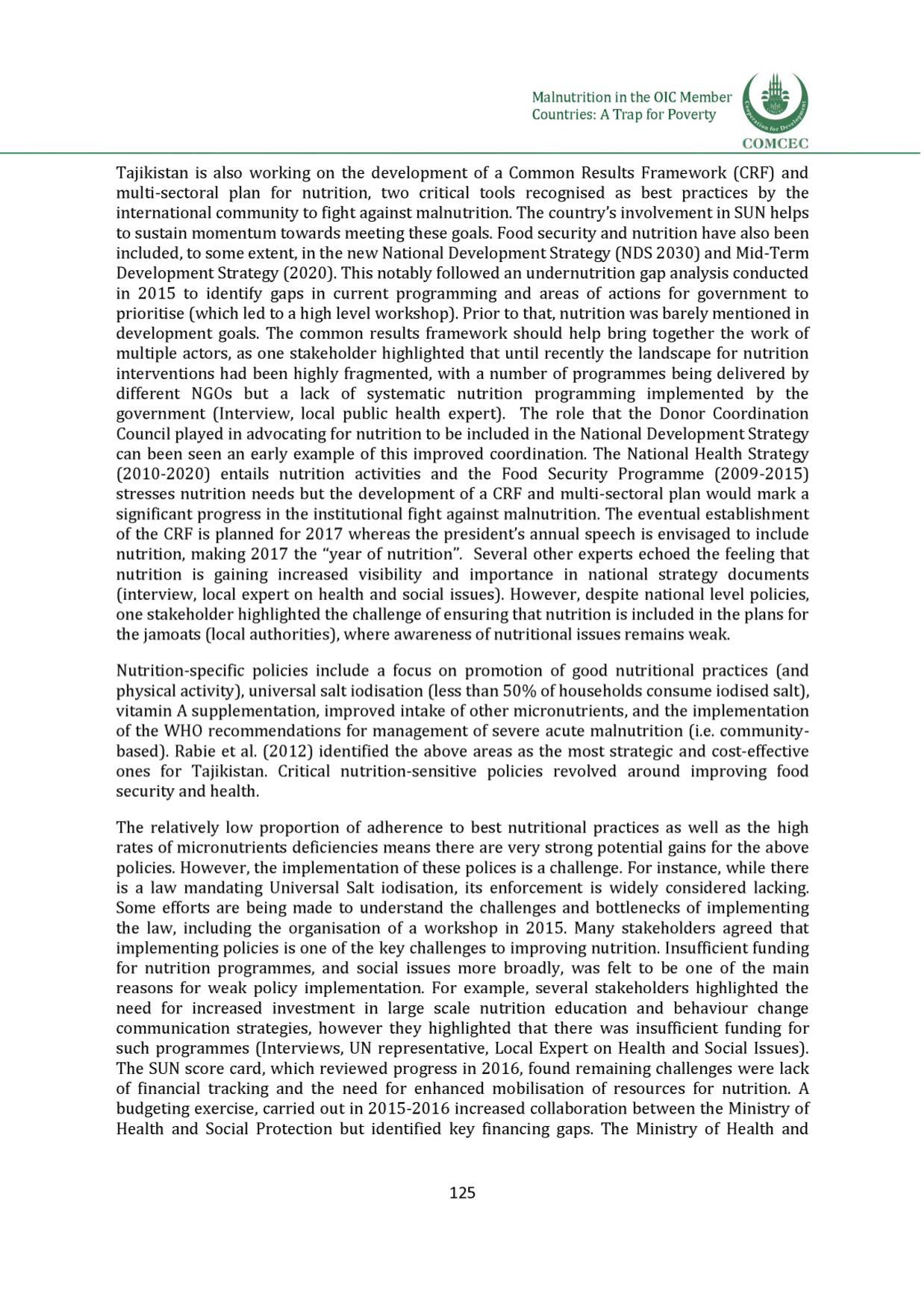

Malnutrition in the OIC Member
Countries: A Trap for Poverty
Tajikistan is also working on the development of a Common Results Framework (CRF) and
multi-sectoral plan for nutrition, two critical tools recognised as best practices by the
international community to fight against malnutrition. The country's involvement in SUN helps
to sustain momentum towards meeting these goals. Food security and nutrition have also been
included, to some extent, in the new National Development Strategy (NDS 2030) and Mid-Term
Development Strategy (2020). This notably followed an undernutrition gap analysis conducted
in 2015 to identify gaps in current programming and areas of actions for government to
prioritise (which led to a high level workshop). Prior to that, nutrition was barely mentioned in
development goals. The common results framework should help bring together the work of
multiple actors, as one stakeholder highlighted that until recently the landscape for nutrition
interventions had been highly fragmented, with a number of programmes being delivered by
different NGOs but a lack of systematic nutrition programming implemented by the
government (Interview, local public health expert). The role that the Donor Coordination
Council played in advocating for nutrition to be included in the National Development Strategy
can been seen an early example of this improved coordination. The National Health Strategy
(2010-2020) entails nutrition activities and the Food Security Programme (2009-2015)
stresses nutrition needs but the development of a CRF and multi-sectoral plan would mark a
significant progress in the institutional fight against malnutrition. The eventual establishment
of the CRF is planned for 2017 whereas the president's annual speech is envisaged to include
nutrition, making 2017 the “year of nutrition”. Several other experts echoed the feeling that
nutrition is gaining increased visibility and importance in national strategy documents
(interview, local expert on health and social issues). However, despite national level policies,
one stakeholder highlighted the challenge of ensuring that nutrition is included in the plans for
the jamoats (local authorities), where awareness of nutritional issues remains weak.
Nutrition-specific policies include a focus on promotion of good nutritional practices (and
physical activity), universal salt iodisation (less than 50% of households consume iodised salt),
vitamin A supplementation, improved intake of other micronutrients, and the implementation
of the WHO recommendations for management of severe acute malnutrition (i.e. community-
based). Rabie et al. (2012) identified the above areas as the most strategic and cost-effective
ones for Tajikistan. Critical nutrition-sensitive policies revolved around improving food
security and health.
The relatively low proportion of adherence to best nutritional practices as well as the high
rates of micronutrients deficiencies means there are very strong potential gains for the above
policies. However, the implementation of these polices is a challenge. For instance, while there
is a law mandating Universal Salt iodisation, its enforcement is widely considered lacking.
Some efforts are being made to understand the challenges and bottlenecks of implementing
the law, including the organisation of a workshop in 2015. Many stakeholders agreed that
implementing policies is one of the key challenges to improving nutrition. Insufficient funding
for nutrition programmes, and social issues more broadly, was felt to be one of the main
reasons for weak policy implementation. For example, several stakeholders highlighted the
need for increased investment in large scale nutrition education and behaviour change
communication strategies, however they highlighted that there was insufficient funding for
such programmes (Interviews, UN representative, Local Expert on Health and Social Issues).
The SUN score card, which reviewed progress in 2016, found remaining challenges were lack
of financial tracking and the need for enhanced mobilisation of resources for nutrition. A
budgeting exercise, carried out in 2015-2016 increased collaboration between the Ministry of
Health and Social Protection but identified key financing gaps. The Ministry of Health and
125
















